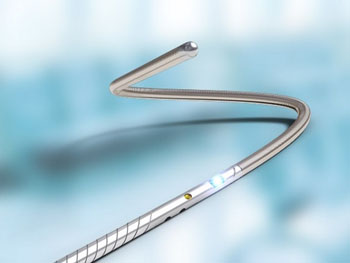Optical Guidewire Provides Reliable FFR Pressure Measurements
By HospiMedica International staff writers
Posted on 04 Apr 2016
A novel guidewire helps measure the severity of coronary stenosis in the treatment of patients with coronary artery disease (CAD).Posted on 04 Apr 2016
The OptoWire II is a nitinol-based optical guidewire developed to measure fractional flow reserve (FFR) using patented optical pressure detection, optical contact, and optical coherence technologies providing a robust signal transmission that enables immediate and reliable connectivity and FFR measurement recovery under extended conditions of usage. The guidewire is designed with a hydrophilic coating to improve its performance, and it is also immune to the many adverse effects related to blood contact.

Image: The OptoWire II FFR optical guidewire (Photo courtesy of Opsens Medical).
The OptoWire II is also designed to provide cardiologists with a guidewire that can help them navigate tortuous coronary arteries and cross highly calcified blockages with ease and safety under different scenarios. This is achieved with the aid of the concentric wire construction, which provides enhanced torque control and steerability performance. The OptoWire II is a product of Opsens Medical (Quebec, Canada), and has been approved by the US Food and Drug Administration (FDA).
“The hydrophilic coating and the increased flexibility profile should facilitate the evaluation of complex coronary blockages, helping cardiologists in deciding on the most appropriate treatment,” said Claude Belleville, vice president of medical devices at Opsens Medical. “This ease of use could help to promote the use of the FFR and further expand access to this diagnostic that improves patient outcomes. We are committed to becoming the first choice of cardiologists, hence helping them to improve the clinical outcome of patients with coronary artery disease.”
FFR is a physiological index to determine the hemodynamic severity of intracoronary lesions. It can accurately identify lesions responsible for ischemia which, in many cases, would have been undetected or not correctly assessed by imaging technologies. Various clinical studies have demonstrated that lesion assessment by FFR to guide routine percutaneous coronary intervention (PCI) is superior to angiography guided treatment. FFR-guided treatment has also been shown to reduce costs due to lower procedural costs, reduced numbers of follow-ups for major adverse cardiac events, and shorter hospital stay.
Related Links:
Opsens Medical














